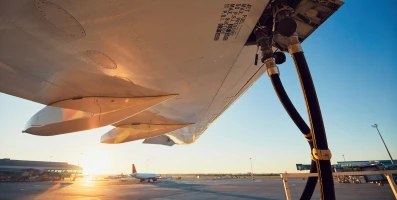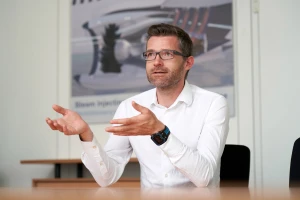innovation
In-flight research
Research aircraft give us new insights into how aviation affects the climate. By enabling us to test new technologies, they help us accelerate the shift toward emissions-free flight.
author: Monika Weiner | 5 mins reading time published on: 06.07.2022
author:
Monika Weiner
has been working as a science journalist since 1985. A geology graduate, she is especially interested in new developments in research and technology, and in their impact on society.
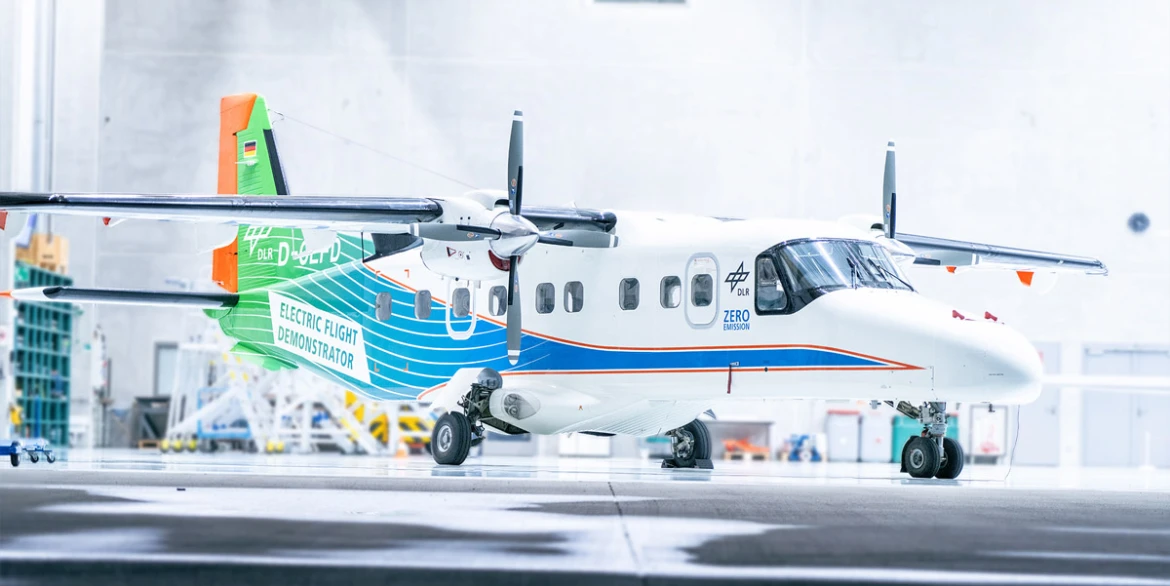
©DLR

German Aerospace Center (DLR): The German Aerospace Center (DLR) is the Federal Republic of Germany’s research center for aeronautics and space. It conducts research and development activities in the fields of aeronautics, space, energy, transport, security and digitalization. Acting on behalf of the German federal government, the German Space Agency at DLR designs and implements the country’s space program.

NASA: NASA (National Aeronautics and Space Administration) is an agency of the U.S. federal government responsible for the civil space program and aeronautics research. Its headquarters are located in Washington, D.C. NASA is also an important geoscientific research institution and provides most of the funding for climate science research in the U.S.
Why are research aircraft an important part of helping reduce aviation emissions?
Making aviation cleaner is an important goal. To achieve it, engineers need more information on the types and quantities of atmospheric pollutants aircraft emit and the extent to which new engines or propulsion technologies can reduce these emissions.
Research aircraft can be used to investigate which substances jet engines release into the atmosphere during flight. By conducting in-flight emission tests, researchers can measure the emissions of various substances, including water, greenhouse gases, particulate matter and soot. As well as determining the timing and quantity of such emissions, these tests also detect the formation of contrails.
What do research aircraft look like?
Research aircraft are like flying laboratories. Equipped with comprehensive sensor systems and analytical tools, they can measure an array of in-flight parameters, including temperature, wind, air quality, pollutants and cloud density. Most research aircraft are commercial or business jets that have been converted to accommodate measuring instruments and computers. Depending on the equipment they carry, they can be used for a wide variety of scientific missions ranging from climate research to Earth observation. However, only a very few research aircraft are able to measure commercial aircraft emissions in the air, among them NASA’s McDonnell Douglas DC-8 and the German Aerospace Center’s Falcon 20-E5.
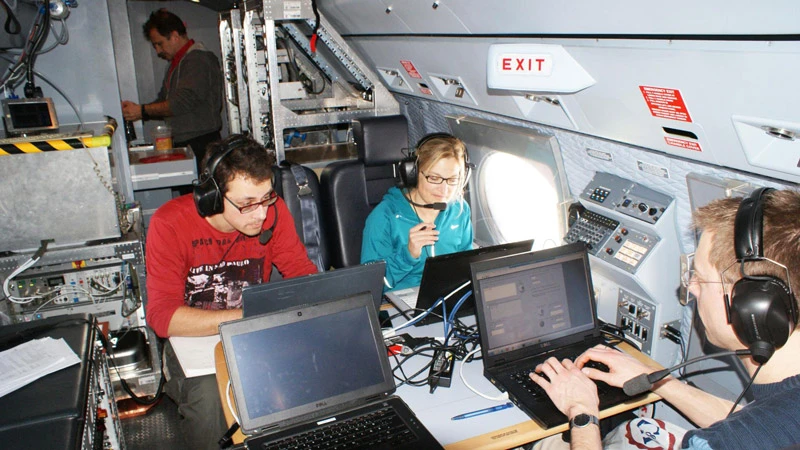
©MPI für Chemie
Research in flight: On each test flight with DLR’s HALO research aircraft, four scientists operate the total of twelve instruments on board, which are used to study the chemical composition of the air.
Flying in the plume of another aircraft is a major challenge for the crew
To measure the emissions of a commercial jet during flight, a research aircraft must fly directly behind it. Flying so close on the tail of another aircraft is tremendously challenging for both the crew and the aircraft, because the passage of the commercial jet in front of them causes significant turbulence. This wake turbulence—also known as wake vortices—is a result of the lift generated by the wing and is produced by all aircraft during flight. The combination of high pressure under the wing and low pressure on top of the wing leads to the formation of two counter-rotating vortices at the tip of each wing. These vortices can be extremely hazardous to any traffic following in an aircraft’s wake. NASA’s Douglas DC-8, for example, must maintain a distance of several miles from the aircraft ahead for safety reasons. Only the most robust and highly maneuverable aircraft, such as the German Aerospace Center’s Falcon 20-E5, can measure emissions directly in an aircraft’s exhaust plume. Pilots must undergo dedicated, specialist training before they can fly this kind of mission. Aircraft used for this purpose must be inspected after each use due to the high stresses involved.
Using aircraft for scientific research
There are only a few dozen research aircraft worldwide. Most of them are operated by research institutions or government agencies such as NASA and the German Aerospace Center (DLR). Europe’s largest fleet, comprising 12 research aircraft, is operated by DLR. It includes the High Altitude and Long Range Research Aircraft (HALO), which is specially equipped for atmospheric physics research, as well as the small and extremely maneuverable Falcon 20-E5, which can fly directly in a jet aircraft’s exhaust plume at a distance of only a few hundred meters. NASA’s DC-8 can also be used to measure in-flight emissions, but it has to remain at a greater distance from the aircraft in front due to its size.

©DLR
High Altitude and Long Range Research Aircraft: The HALO research aircraft opens a new chapter in the history of German atmospheric research and Earth observation. HALO is based on a Gulfstream G550 ultra-long range business jet.

©DLR
Dassault Falcon 20-E5: The aircraft operated by the research department in Oberpfaffenhofen is for experiments in environmental and climate research. Due to its layout and compact design, this Falcon is highly maneuverable.

©NASA Photo
Douglas DC-8: NASA operates a heavily modified Douglas DC-8 jetliner as an airborne science laboratory. It collects data for projects that serve the world’s scientific community.
What measuring equipment do research aircraft have on board?
The specific equipment depends on the type of aircraft and the mission objectives. For example, the Falcon 20-E5 is equipped with a nose boom. This contains meteorological sensors that provide highly accurate readings of the wind direction in three dimensions, as well as humidity, pressure and temperature. During the flight, ambient air is channeled into the aircraft through inlets on the fuselage and analyzed for trace gases. At the same time, underwing probes are used to detect particulate matter including soot and ice particles.
The High Altitude and Long Range Research Aircraft (HALO)—a Gulfstream G550 business jet—has all the necessary equipment on board to study basic atmospheric physics. HALO is a significantly larger atmospheric research aircraft that includes 20 inlets to carry air to on-board instruments. It has viewing windows up to 50 centimeters in size through which lasers can be fired to measure the properties of clouds.
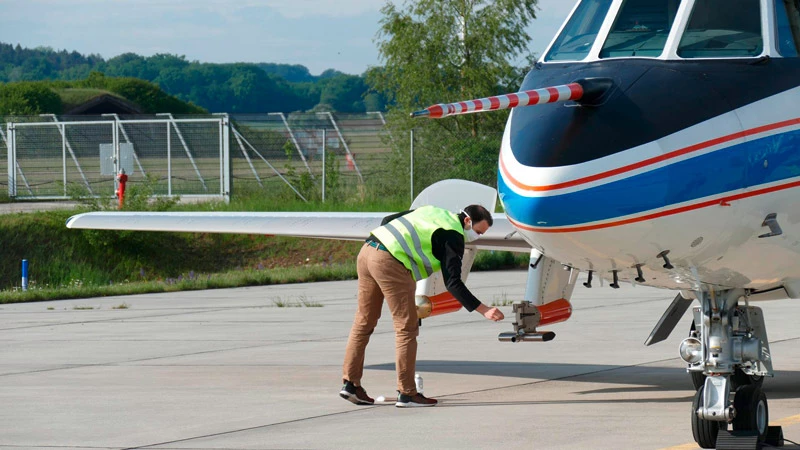

©DLR


©DLR
Test of the cloud probe on the Falcon 20E: Prior to a flight of this DLR research aircraft, the cloud probes are tested. These measure physical properties of the ice crystals in the contrail during flight.
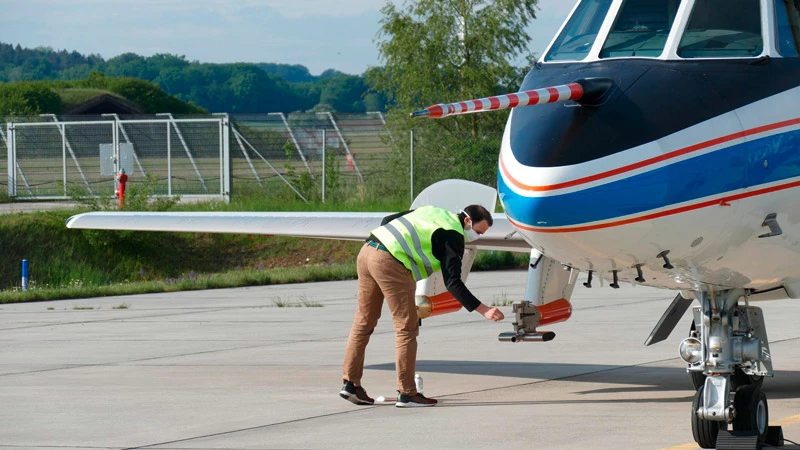
©DLR
What insights do emission measurements offer?
Research flights conducted over recent years have confirmed the feasibility of reducing aviation emissions. One way of achieving this is by using sustainable aviation fuels (SAF), which contain no aromatics or sulphur and can be produced using renewable energy. During the 2018 mission, in which NASA’s Douglas DC-8 followed a DLR Airbus A320 fueled with a 50-percent blend of SAF and conventional jet fuel, the researchers discovered that the soot emissions were lower than those of an aircraft powered solely by conventional fuel.
Even fewer soot particles were measured during the 2021 research mission, in which DLR’s Falcon 20-E5 followed an Airbus A350 fueled solely by SAF. This is important, because water vapor from a jet’s exhaust and from the atmosphere can condense onto soot particles. If the ambient air at an altitude of 8 to 12 kilometers is cold enough, these droplets then turn into ice crystals that form contrails, which can remain in the sky for several hours. These contrails reduce Earth’s radiation of heat into space, thereby contributing to global warming. Thus, less soot ultimately means fewer contrails, which is good for the climate.
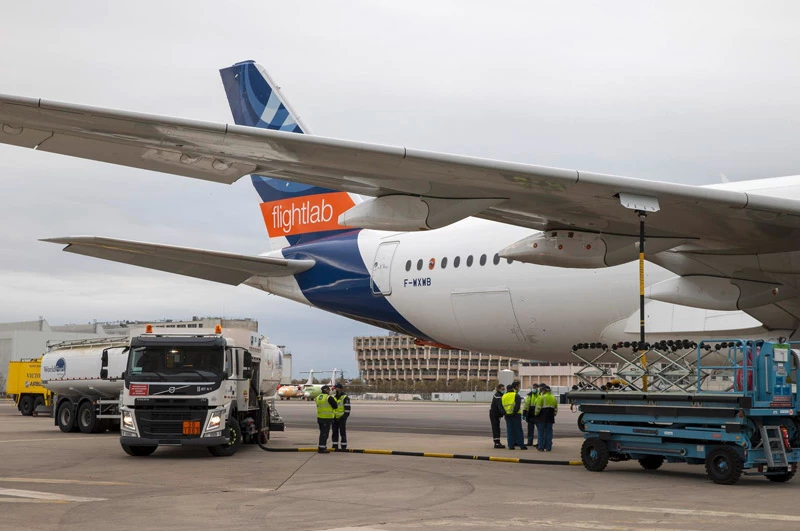

©Airbus/S.Ramadier


©Airbus/S.Ramadier
Refueling the A350: At the Toulouse site, the Airbus A350-900 is refueled for its first flight with 100 percent sustainable aviation fuel.

©Airbus/S.Ramadier
Is emissions-free flight possible?
Hydrogen is a clean alternative to conventional fuels. It can be produced sustainably with green energy and then converted into electricity in the aircraft using a fuel cell. The only byproduct of this process is water. The electricity generated by the fuel cell can be used to power a propulsion system consisting of an electric motor and propeller. However, this requires the use of entirely new electric propulsion technology.
MTU Aero Engines is currently working with DLR to develop this technology. MTU engineers are already working on a 600-kilowatt electric powertrain that is due to be tested in a DLR Do228 research aircraft. For safety reasons, only one of the engines will be replaced by an electric motor; in an emergency, the aircraft will still be able to fly and land using the second turboprop engine. Test flights are scheduled to start in the middle of the decade.
What contribution could research aircraft make to aviation in the future?
As well as achieving emissions-free flight, researchers are also keen to make aircraft more efficient in the future by improving the physics of flight. For example, one way to reduce fuel consumption and minimize contrails would be to improve aerodynamics while simultaneously optimizing flight paths. The Falcon 2000LX ISTAR airborne research platform is designed to help achieve this goal. ISTAR—which stands for In-flight Systems & Technology Airborne Research—is a next-generation research aircraft that enables researchers to test the properties of new aircraft designs on a digital twin during development and then again under real-world operating conditions. The aim is to make aircraft development faster and cheaper, much as in the automotive industry, which uses computer models to conduct virtual vehicle testing long before the first real-life crash tests take place.




